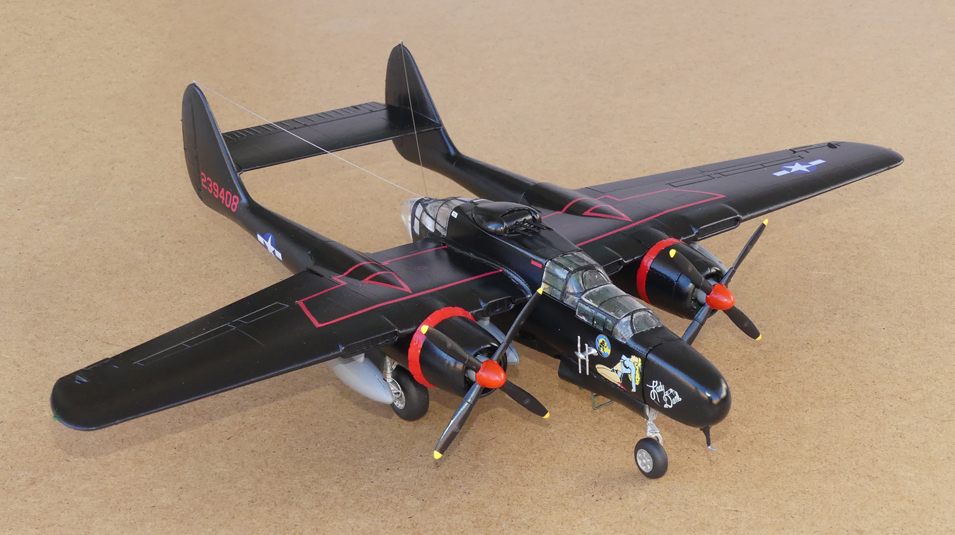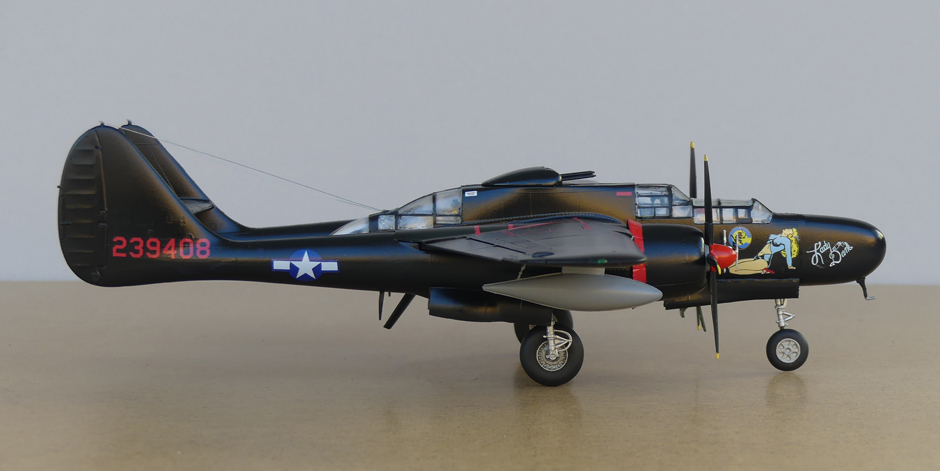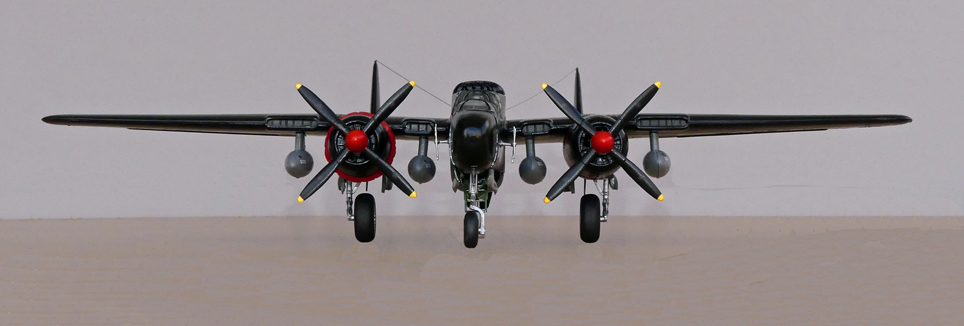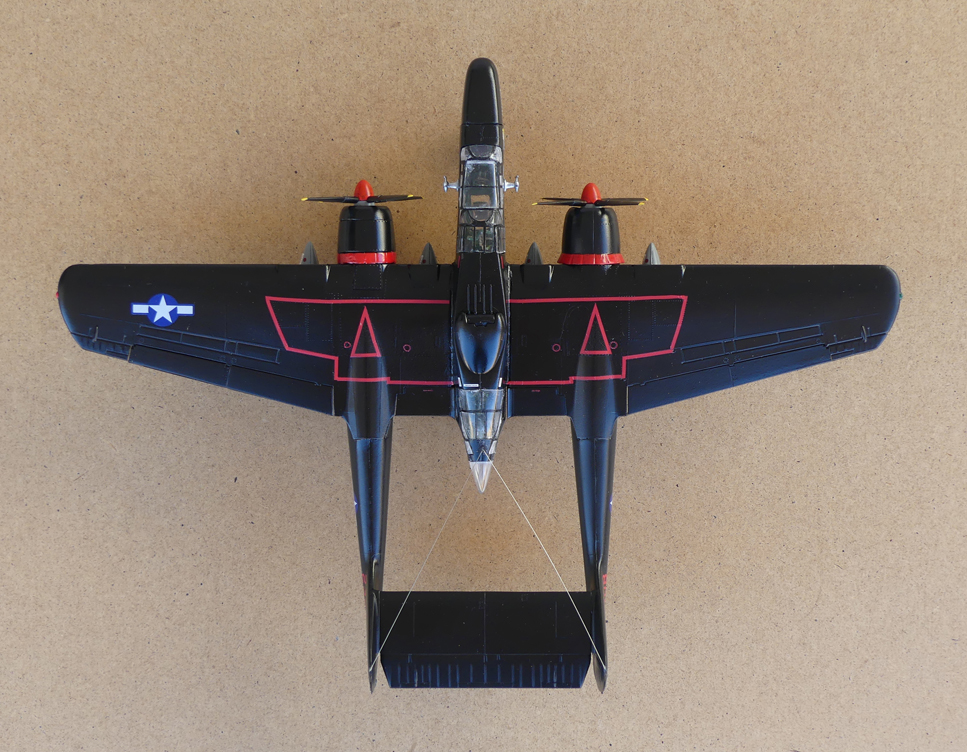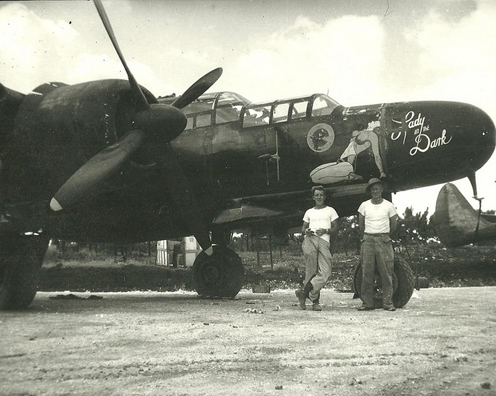
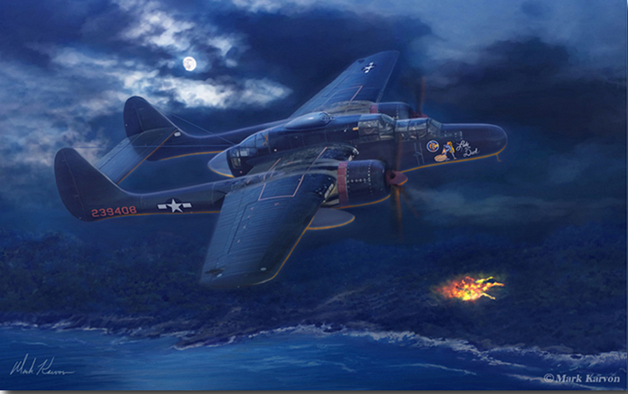


The Northrop P-61 Black Widow is a twin-engine United States Army Air Forces fighter aircraft of World War II.
It was the first operational U.S. warplane designed as a night fighter. Named for the North American spider Latrodectus mactans, it was an all-metal, twin-engine, twin-boom design armed with four forward-firing 20 mm (.79 in) Hispano M2 autocannon in the lower fuselage, and four .50 in (12.7 mm) M2 Browning machine guns in a dorsal gun turret. Developed during the war, the first test flight was made on May 26, 1942, with the first production aircraft rolling off the assembly line in October 1943.
The P-61 was the first fighter aircraft to have Radar. It was a scanning radio transmitter mounted in the aircraft nose. In Airborne Intercept mode, it had a range of nearly 5 mi (8.0 km). The unit could also function as an airborne beacon/homing device, navigational aid, or in concert with interrogator-responder IFF units. The P-61's radar operator located targets on his scope and steered the unit to track them, vectoring and steering the pilot to the radar target via oral instruction and correction. Once within range, the pilot used a smaller scope integrated into the main instrument panel to track and close on the target.
The P-61's spine-mounted dorsal remote turret could be aimed and fired by the gunner or radar operator, who both had aiming control and gyroscopic collimator sighting posts attached to their swiveling seats. They could also be locked forward to be fired by the pilot in addition to the 20 mm (.79 in) cannon. The radar operator could rotate the turret to engage targets behind the aircraft. Capable of a full 360° rotation and 90° elevation, the turret could be used to engage any target in the hemisphere above and to the sides of the P-61.
Although not produced in the large numbers of its contemporaries, the Black Widow was operated effectively as a night fighter by United States Army Air Forces squadrons in the European Theater, Pacific Theater, China Burma India Theater, and Mediterranean Theater during World War II. It replaced earlier British-designed night-fighter aircraft that had been updated to incorporate radar when it became available. After the war, the P-61 was redesignated as the F-61 and served in the United States Air Force as a long-range, all-weather, day/night interceptor for Air Defense Command until 1948, and for the Fifth Air Force until 1950. The P-61 was also modified to create the F-15 Reporter photo-reconnaissance aircraft for the United States Army Air Forces and subsequently the United States Air Force. The last aircraft was retired from government service in 1954.
Historian Warren Thompson wrote that "it is widely believed" that the last enemy aircraft destroyed in combat before the Japanese surrender was downed by a P-61B-2 named "Lady in the Dark" (s/n 42-39408) of the 548th NFS based on Iwo Jima. The aircraft piloted by Lieutenant Robert W. Clyde and R/O Lieutenant Bruce K. LeFord on 14/15 August 1945 claimed a Nakajima Ki-44 "Tojo." The destruction of the "Tojo" came without a shot being fired; after the pilot of the "Tojo" sighted the attacking P-61, he descended to wave-top level and began a series of evasive maneuvers. These ended with his aircraft striking the water and exploding. Clyde and LeFord were never officially credited with this possible final kill of the war.
Facts and General Characteristics of the P-61B-2 Black Widow:
Manufacturer: Northrop
Type: Night fighter
Crew: 2–3 (pilot, radar operator, optional gunner)
Wingspan: 66 ft 0 in (20.12 m)
Length: 74 ft. 4 in. (22.66 m)
Height: 14 ft. 8 in. (4.47 m)
Empty weight: 23,450 lbs. (10,637 kg)
Gross weight: 29,700 lbs. (13,472 kg)
Max takeoff weight: 36,200 lb. (16,420 kg)
Fuel capacity: 640 US gal (2,400 L) internal and up to four 165 US gal. (625 L) drop tanks.
Powerplant: 2 × Pratt & Whitney R-2800-65W Double Wasp 18-cylinder air-cooled radial piston engines, 2,250 hp (1,680 kW) each.
Propellers: 2 X 4-bladed Curtiss Electric constant-speed feathering propellers, 12 ft. 2 in. (3.72 m) diameter.
Max speed: 366 mph (589 km/h) at 20,000 ft (6,100 m)
Service ceiling: 33,100 ft. (10,100 m)
Range: 1,350 miles (2,170 km)
Armament: Guns: 4 × 20 mm (.79 in) Hispano AN/M2 cannon in ventral fuselage, 200 rounds per gun and 4 × .50 in (12.7 mm) M2 Browning machine guns in remotely operated, full-traverse upper turret, 560 rpg.
Bomb load: for ground attack, four bombs of up to 1,600 lbs. (726 kg) each or six 5-in. (127 mm) HVAR unguided rockets could be carried under the wings. Some aircraft could also carry one 1,000 lb. (454 kg) bomb under the fuselage.
Avionics: SCR-720 (AI Mk.X) search radar and SCR-695 tail warning radar.
Facts and General Characteristics of the Model:
The paint scheme and markings of this model represent the P-61B-2 S/N 42-39408 "Lady in the Dark" of the 548th Night Fighter Squadron based on Iwo Jima in August 1945. It is equipped with four 165 gal. (625 L) external fuel drop tanks. I bought after-market decals to match the actual aircraft and photo-etched brass parts to add detail to interior.
Like all my other models, I don’t portray weathering or wear. I paint the planes as they looked coming out of the factories but I do include the nose art and crew names which were added after the planes entered service.
Model manufacturer: Revell, Inc. (Made in China)
Photo-etched brass parts: Eduard-Model Accessories, Czech Republic
Scale: 1/48
Wingspan: 16.25”
Length: 12.25”
Height (tip of vertical stabilizer): 3.8”
Plastic parts used: 126
Photo-etched brass interior parts used: 53
Decals used: 42
Hours to build and paint airplane and figures: 52
Problems:
1. The wings did not fit into the fuselage straight which caused the twin booms to misalign and made the horizontal stabilizer crooked.
2. The two front canopy panels that could be displayed in the open position as an option, did not fit in the closed positon and left large gaps when glued in place.
3. The rear (red) section of the engine nacelles do not match.
4. Some illustrations in the instructions were not clear as to part locations.
5. The after-market decals were thin and very difficult to apply without twisting or damaging them.
6. I didn’t use about 20 of the tiny red word decals that came with the kit because they were almost invisible against the black body paint.
Mistakes:
1. I should have used Tamiya spray paint instead of Testors spray paint which does not leave a smooth surface.
2. The canopy painting did not come out sharp due to difficult masking.
3. The canopies ended up fogged in many places as the super glue I used reacted with the oil from my fingers. I should have used a different glue on the canopies.
4. The nose wheel was supposed to be steerable but I glued it in place. The upper gun turret and propellers are movable.
5. The nose wheel had an optional fender. I didn’t use it but later found out that this aircraft did have the fender (see historic photo at the top).
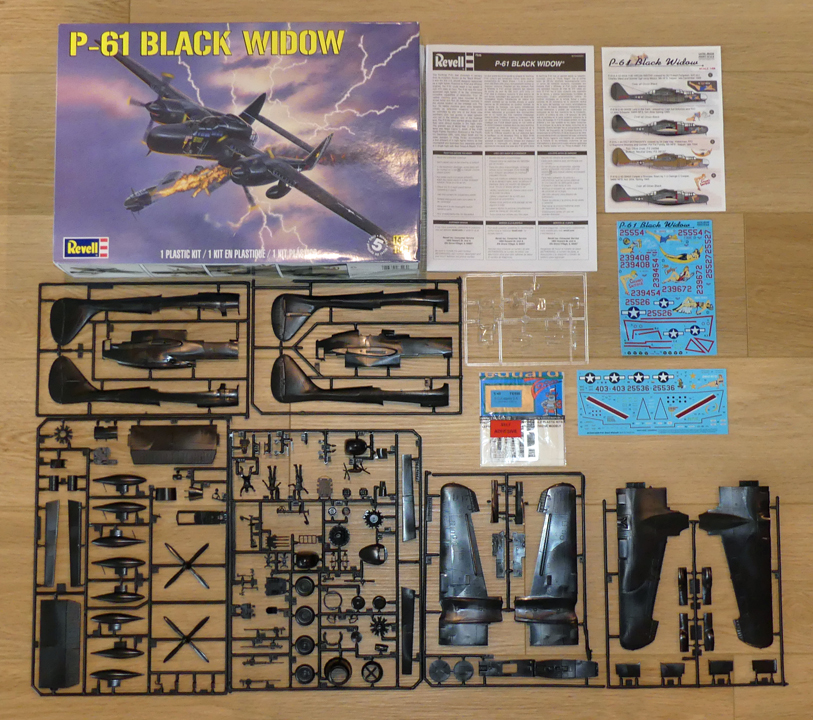

Photo-etched brass parts.

Interior showing some of the photo-etched parts.
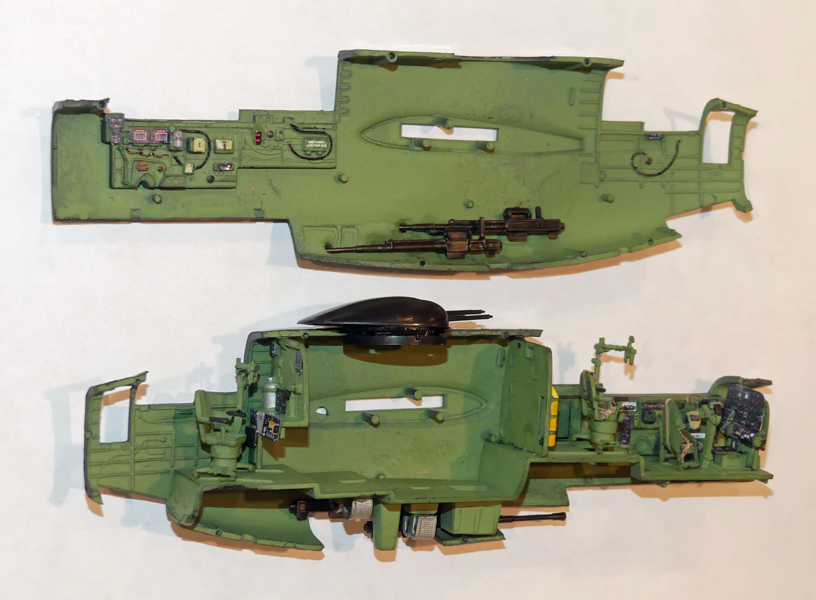
Interior showing all three crew positions, two of the 20 mm (.79 in) Hispano AN/M2 cannons and ammunition chutes.
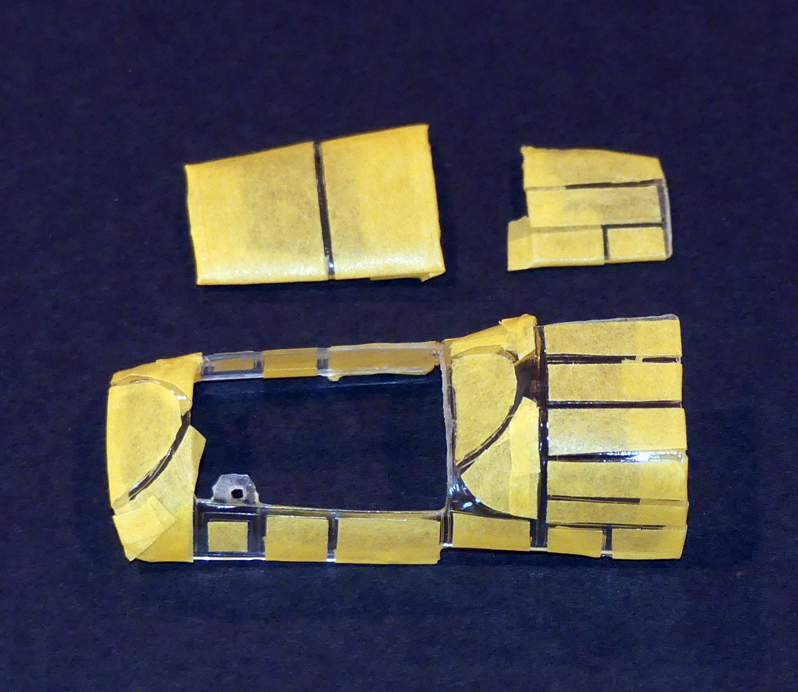
Forward canopy. This was one of the hardest canopies for me to mask. There were 27 panels to mask on the three pieces. The two smaller pieces did not fit into the larger piece without big gaps so I used clear filler.
